Review Charger Xtar VC8

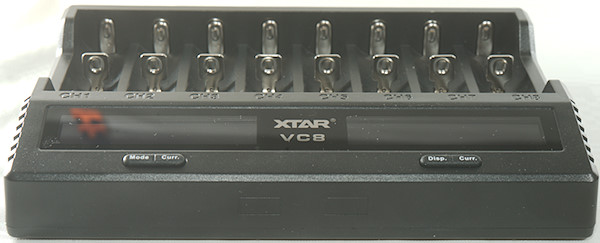
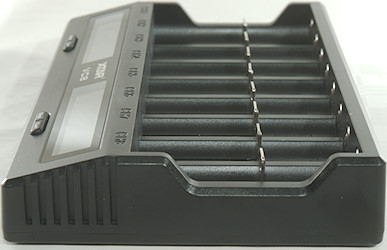
A eight slot LiIon and NiMH charge with automatic current selection, it is USB powered, preferable from a QC supply.
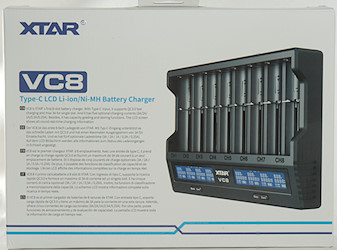

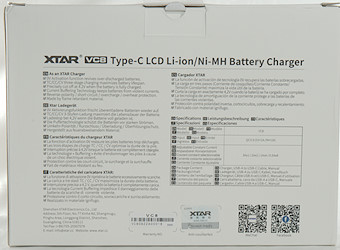

The charger was in a white cardboard with specifications on it.
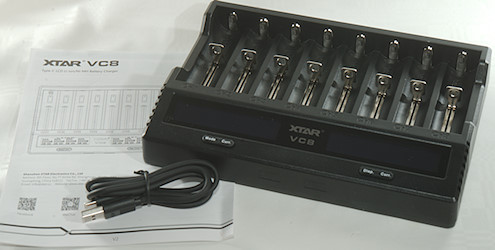
The box included the charger, a USB cable and a instruction sheet.
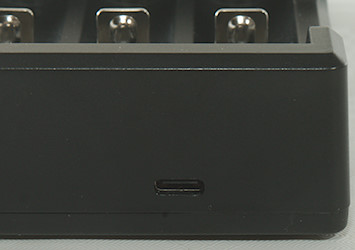
The charger has a USB type-C input, the supplied cable is a USB-C to a old style USB-A connector.

The charger has two displays and four buttons. It is two partly identical sections.
Button Mode/Disp.: This select between current, capacity and IR display, hold down to select grade and store function (Only first section).
Button Curr.: Selects maximum charge current, but the automatic detection will reduce this to what it decides is safe.


During power on all segments are shown, when it changes to idle only the selected function is shown.

Actual battery current, the charger is charging on slot #1 and still preparing for slot #3 & #4.

Actual battery current.

Capacity.

Internal resistance.
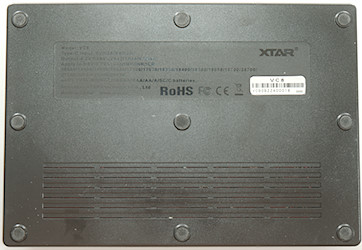
The charger has specifications on the back, with black text on black background.
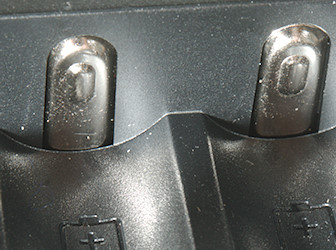
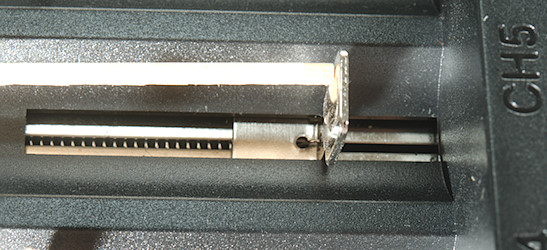
The connection are the common slider style that can handle from 32mm to 76mm, this means all batteries will fit.


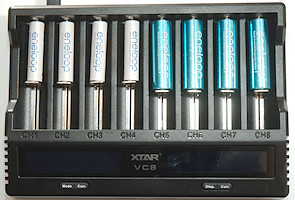

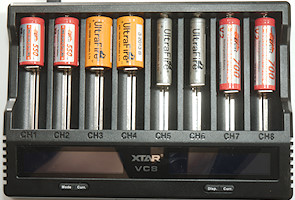
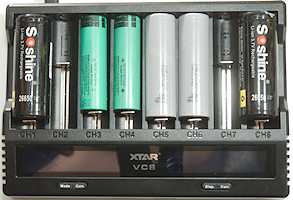
Measurements charger
- When not powered it will discharge a LiIon battery with about 2.2mA and NiMh with about 0.3mA
- When powered the charge will charge with less than 0.6mA when finished.
- Below 2V the battery is assumed to be NiMH, above LiIon.
- Charger will restart if battery voltage drops below 3.9V.
- Voltmeter is within 0.02V
- Voltmeter will stop updating when charging stops.
- Slot #1 & #8 has a 3A current setting.
- All slots has .25A, 0.5A, 1A & 2A current settings.
- Charger uses QC at 9V on both normal USB and USB-C
- Background light goes to low brightness after 60 seconds.
- Power consumption when idle without batteries is 110mA from USB with backlight on full and drop to 77mA when brightness is reduced.
Charging LiIon
Some of my test was done with 5V and some with QC where the charger uses 9V. In some cases I manually selected the current, in other I let the charger do it. If there is a DC input current trace the charger has a 5V supply in other cases a QC charger is used for supply.
In all test I have test equipment connected between the battery and the charger (For the 8 battery test I only have equipment on one battery). It has a few mOhm resistance and some contact resistance.
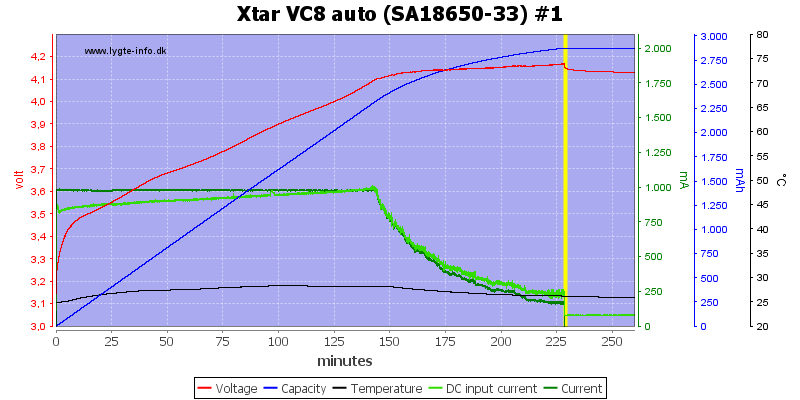
A standard CC/CV charge curve, the charger decided to use 1A charge current. Termination current is around 170mA.
Display shows: 2958mAh 69mOhm
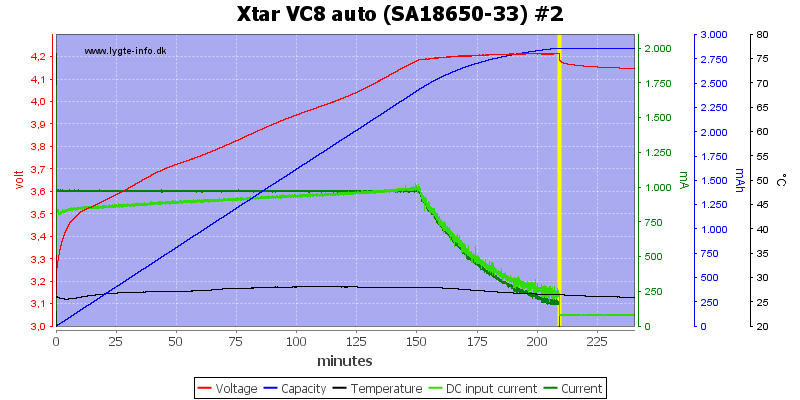
Display shows: 2956mAh 0mOhm
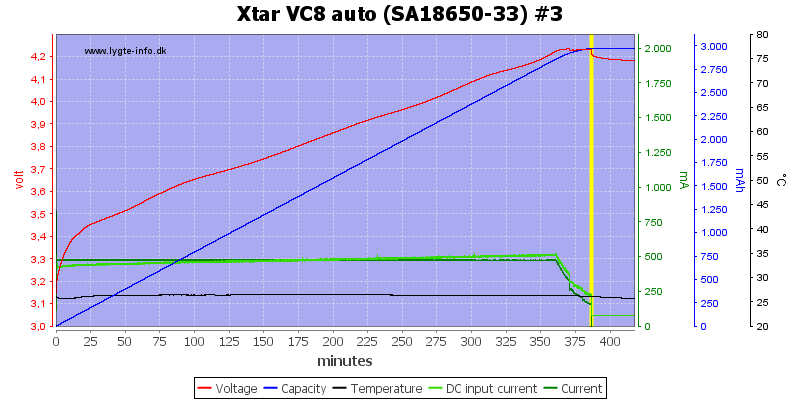
This time the charger used 0.5A charge current. There is no IR reading on the display.
Display shows: 3137mAh 0mOhm

Display shows: 3061mAh 82mOhm
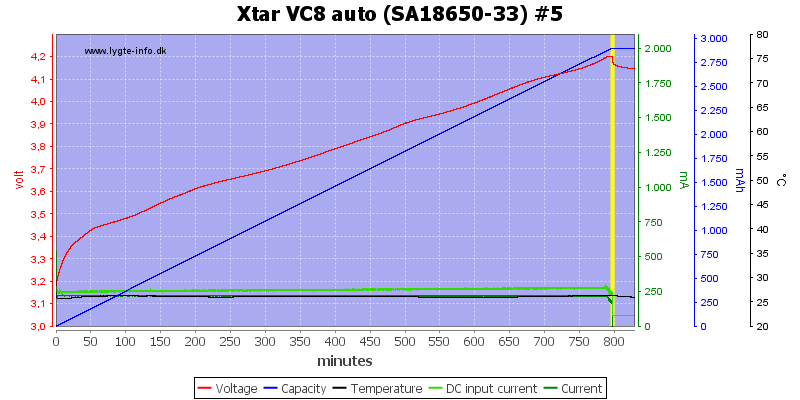
For this battery the selected current was 0.25A, this is rather low. There is no IR reading on the display.
Display shows: 2968mAh 0mOhm
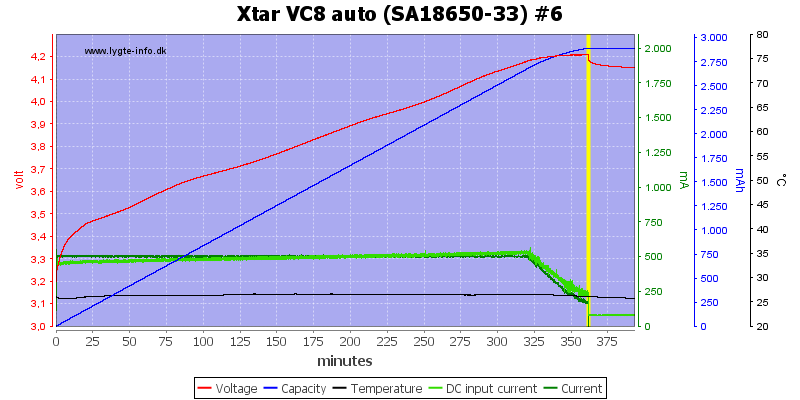
This battery has a fairly high internal resistance according to the charger.
Display shows: 2895mAh 128mOhm
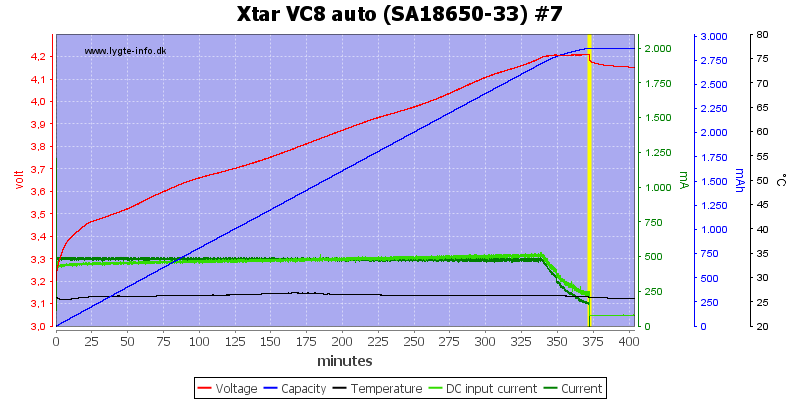
Display shows: 2861mAh 0mOhm

Display shows: 3221mAh 0mOhm
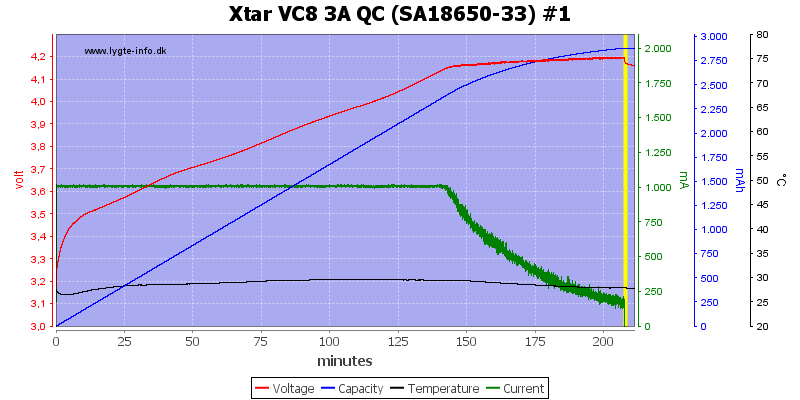
I selected 3A charge current to get a faster charging, but it did not work.
Display shows: 2866mAh 62mOhm
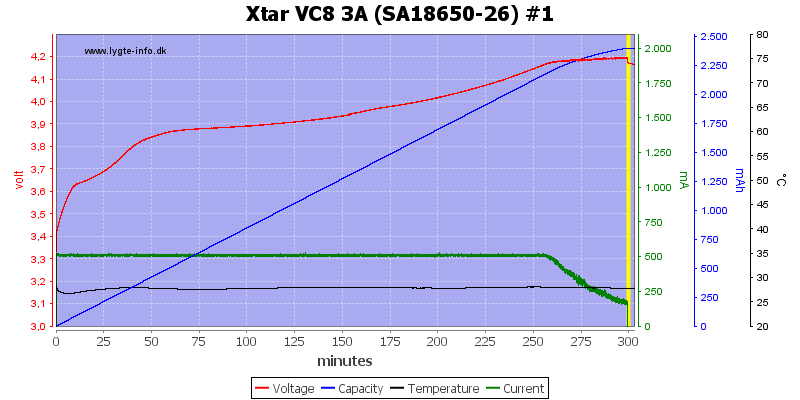
Display shows: 2366mAh 143mOhm
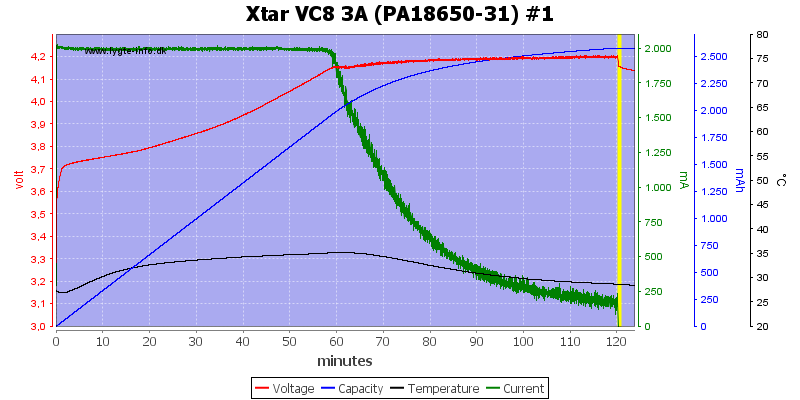
This time I got lucky and the charger decided to use 2A charge current.
Display shows: 2633mAh 57mOhm

Display shows: 2913mAh 65mOhm
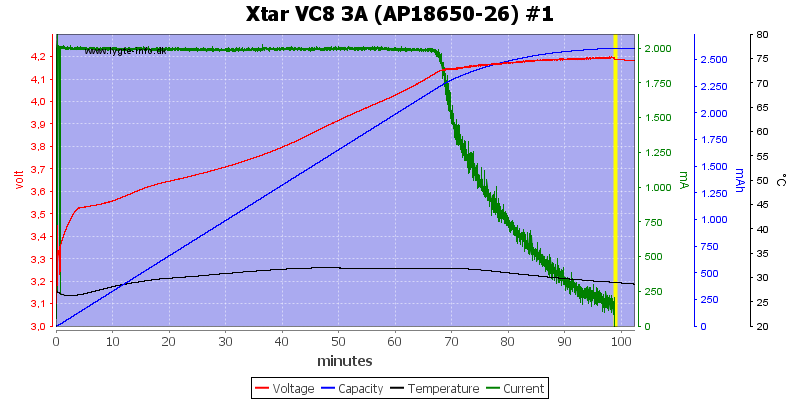
Display shows: 2658mAh 49mOhm

This old cell got 0.5A charge current and registered 245mOhm in internal resistance.
Display shows: 1748mAh 245mOhm
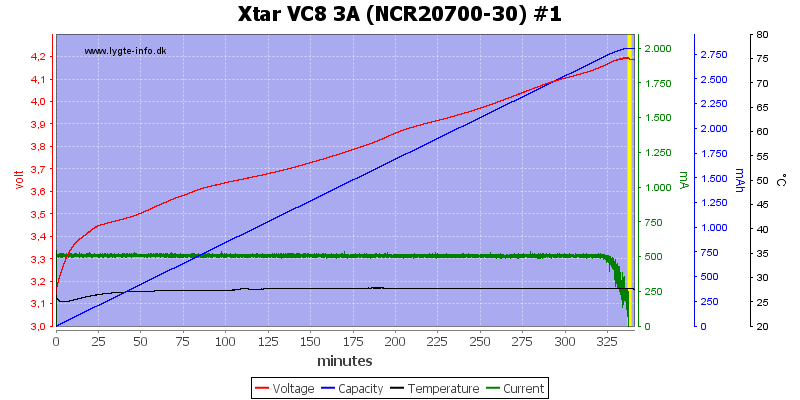
Display shows: 2786mAh 119mOhm
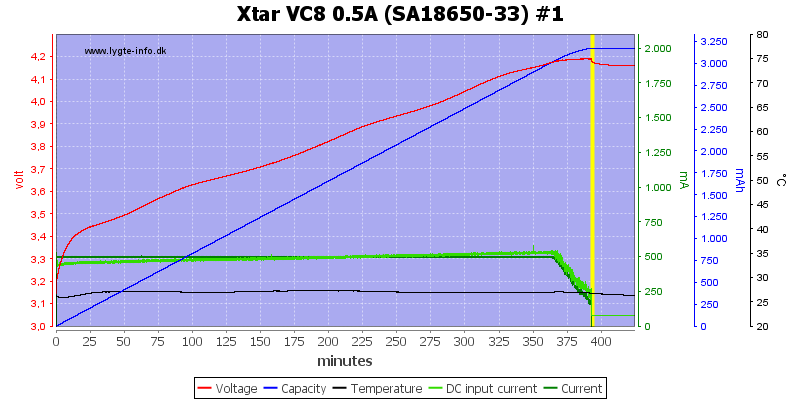
Display shows: 3201mAh 49mOhm
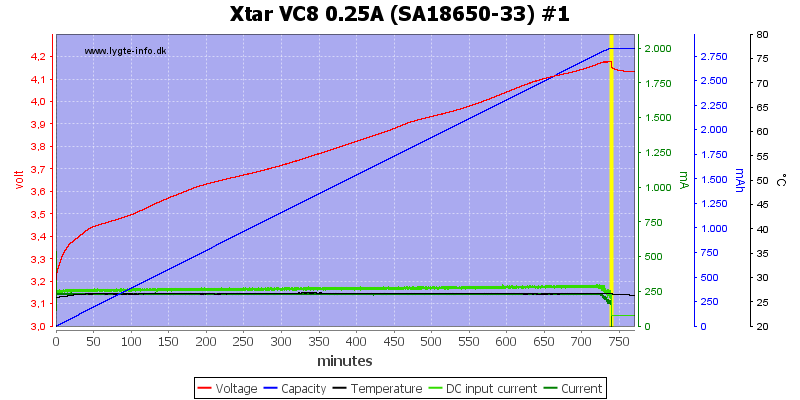
The current selection can force the current down, here I have selected 0.25A and the charger uses it.
Display shows: 3025mAh 116mOhm
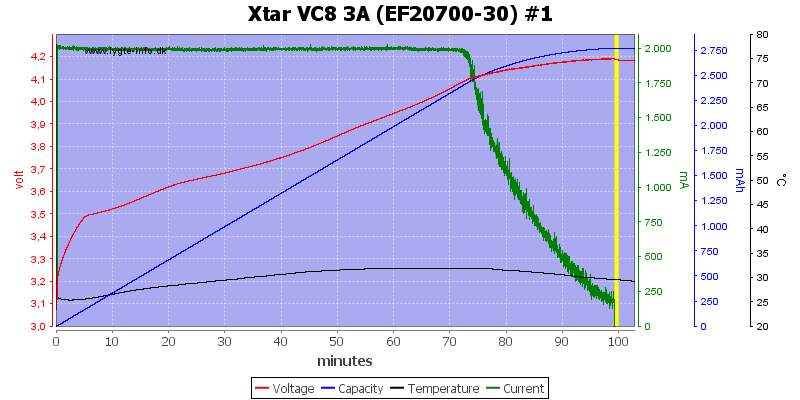
A larger cell, this time I got the current up to 2A
Display shows: 2822mAh 53mOhm

Display shows: 878mAh 246mOhm

Here I charge 8 batteries with a QC supply and current selected to 2A, actual current is around 0.5A. This is very reasonable for a 9V 2A supply (Even a bit on the high side, it may have used lower rate on some batteries).
Display shows:
Capacity: 2618mAh, 3001mAh, 3552mAh, 3223mAh, 2909mAh, 2861mAh, 2956mAh, 3061mAH
Resistance: 90mOhm, 44mOhm, 31mOhm, 31mOhm, 32mOhm, 33mOhm, 30mOhm, 29mOhm
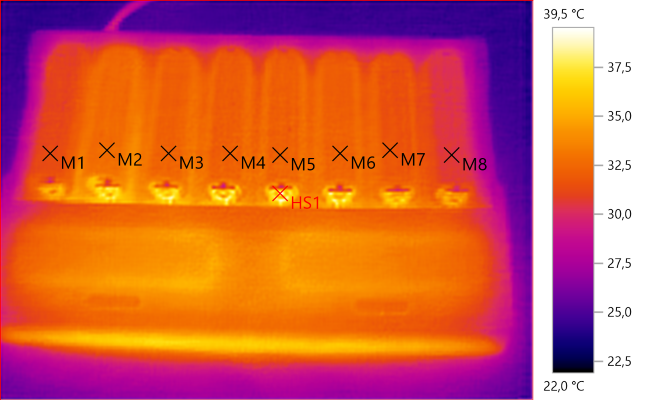
M1: 31.3°C, M2: 32.9°C, M3: 32.3°C, M4: 32.3°C, M5: 32.4°C, M6: 32.3°C, M7: 31.8°C, M8: 30.6°C, HS1: 39.5°C
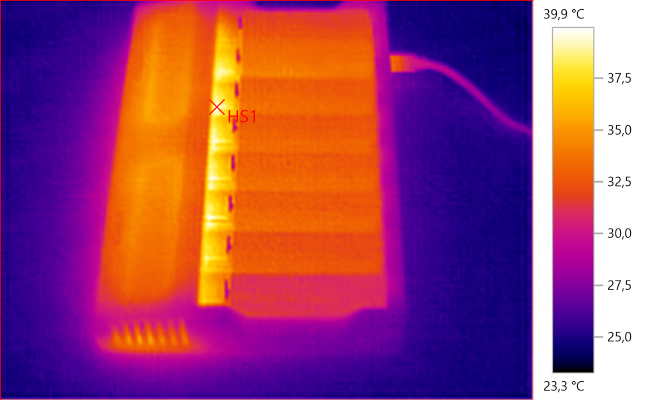
HS1: 39.9°C
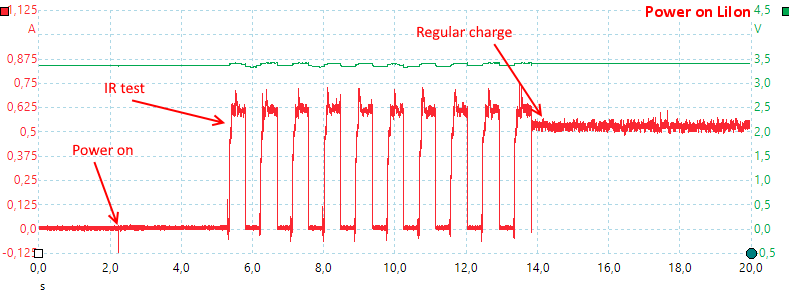
The charger needs about 12 seconds to turn on, some of the time is used to measure the internal resistance.
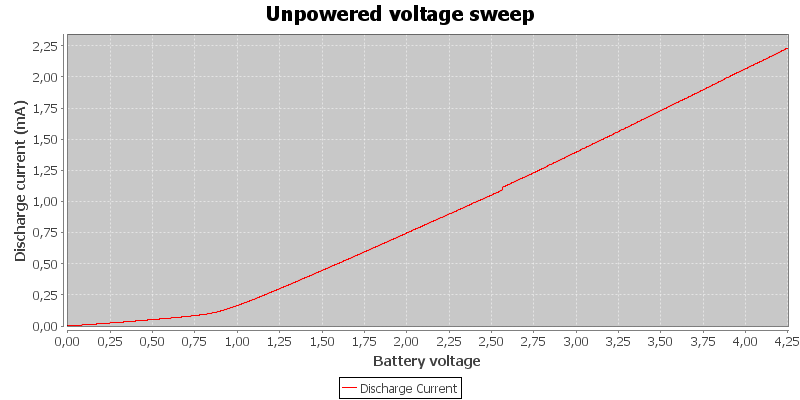
The charger will discharge a full LiIon battery with about 2.2mA when not powered.
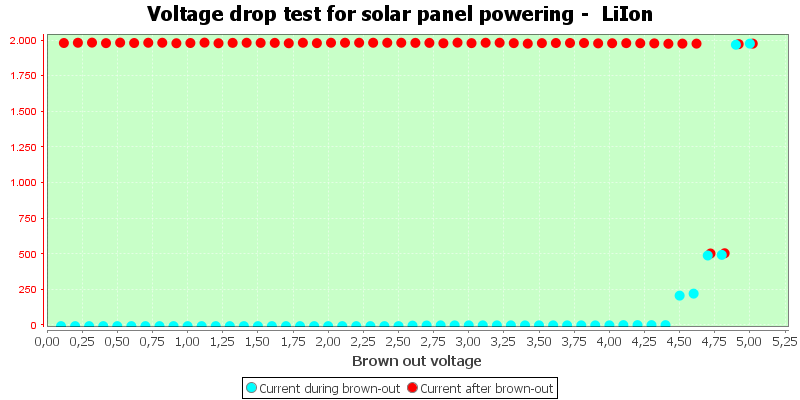
The charger will did rather well with unstable supply.
Grading LiIon
A grading sequence consist of charge the battery, discharging it while measuring capacity and the charging it again. Due to the low currents it is done at it takes a lot of time to do. This function is only available on the first four slots.
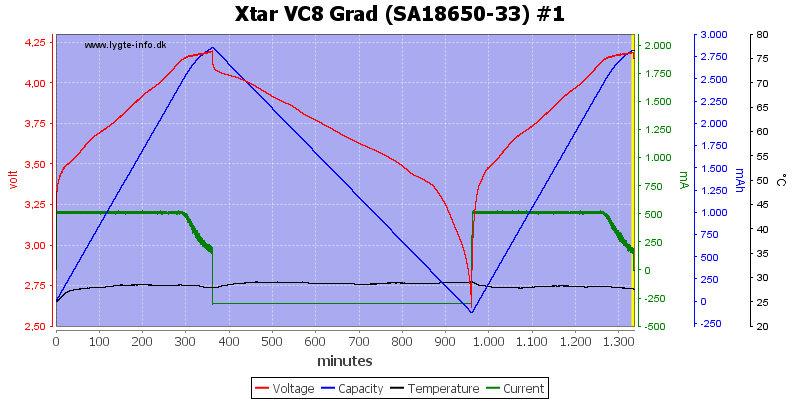
The battery is discharged to around 2.6V with a current of about 300mA
Display shows: 3024mAh
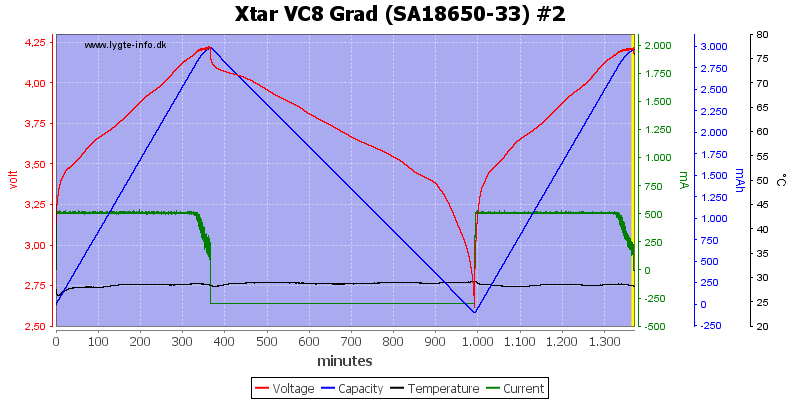
Display shows: 3164mAh
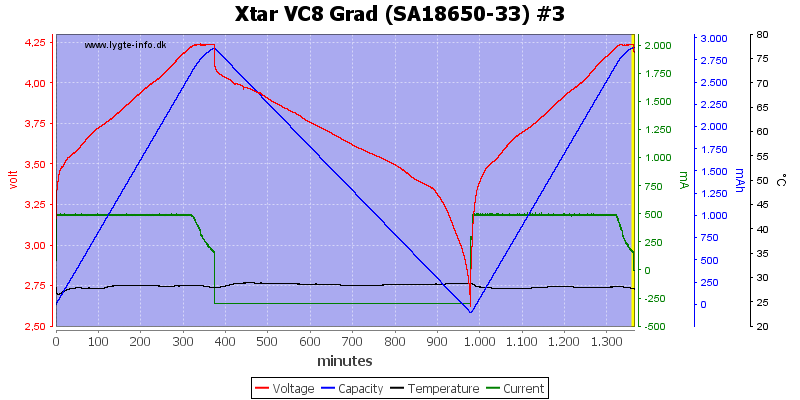
Display shows: 3056mAh
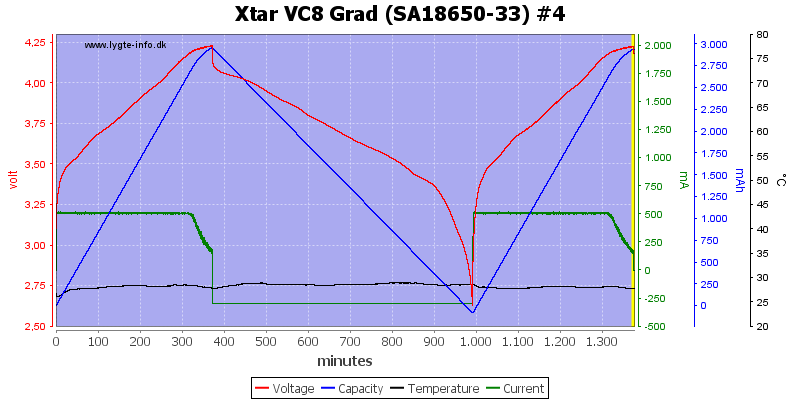
Display shows: 3132mAh
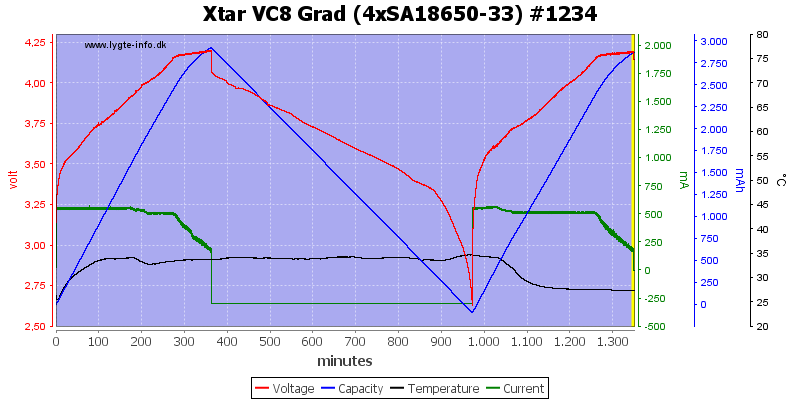
Display shows: 3075mAh, 3193mAh, 3176mAh, 3234mAh
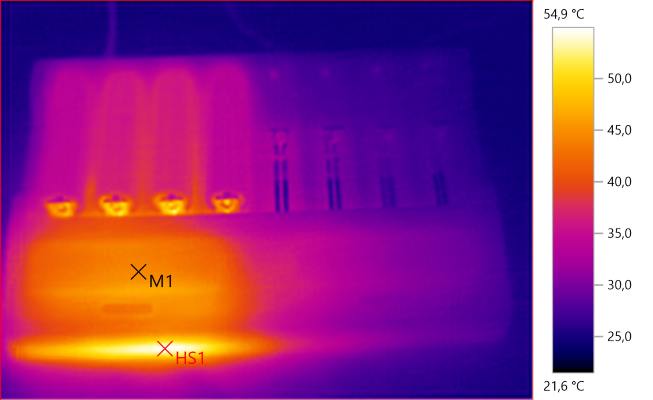
M1: 44.5°C, HS1: 54.9°C
It looks like the heat from discharging is dissipated at the front of the charger, i.e. away from the batteries (Good).
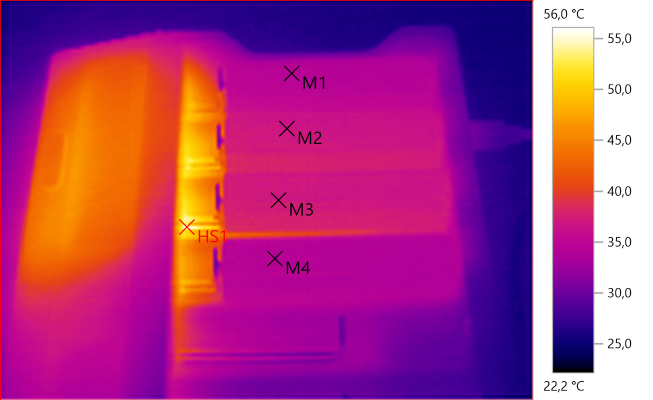
M1: 34.6°C, M2: 36.8°C, M3: 37.1°C, M4: 34.3°C, HS1: 56.0°C
Storing LiIon
The store function will bring the batteries to a half charged state, this is the best way to keep batteries for long time storage (Keeping them at a cool place is also a very good idea). This function is only available on the first four slots.
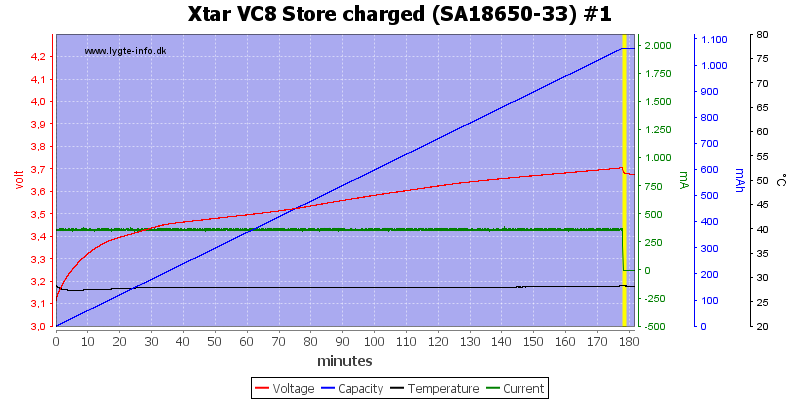
It can charger to half full.
Display shows: 3.70V
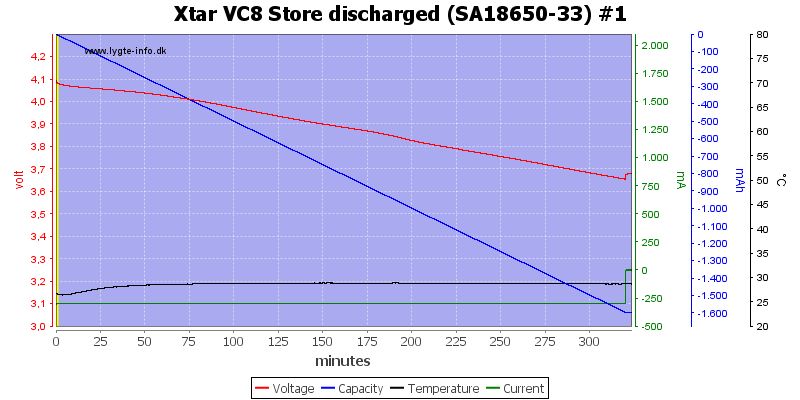
But is can also discharge to half full.
Display shows: 3.68V
Charging NiMH
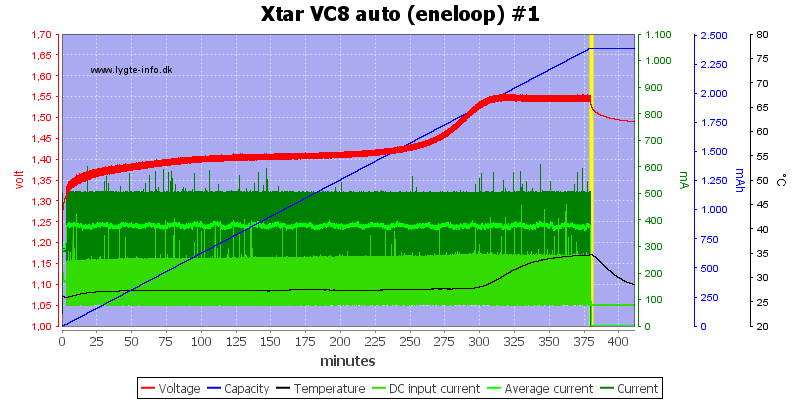
This looks like a charging with -dv/dt termination or maybe 0dv/dt termination. The charger is fairly slow to terminate. There is no trickle charge.
Display shows: 2366mAh, 113mOhm
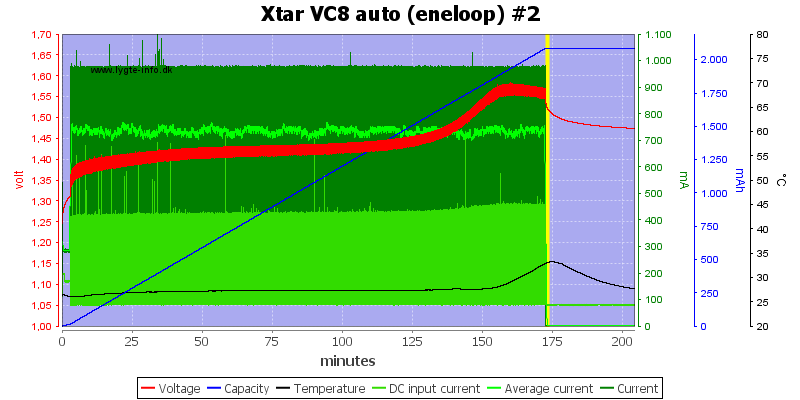
Termination speed is better here and charge current is higher.
Display shows: 2134mAh, 64mOhm
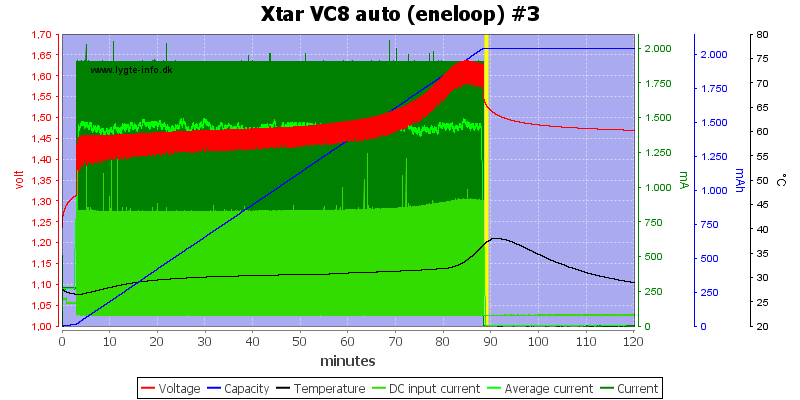
This is a rather fast charge at 1.5A (Current is 2A), with a good termination.
Display shows: 2143mAh, 57mOhm
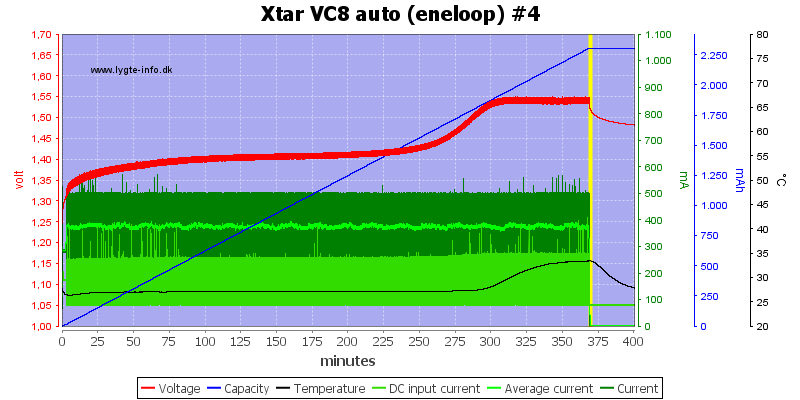
Again a low current charge with a slow termination.
Display shows: 2299mAh, 231mOhm
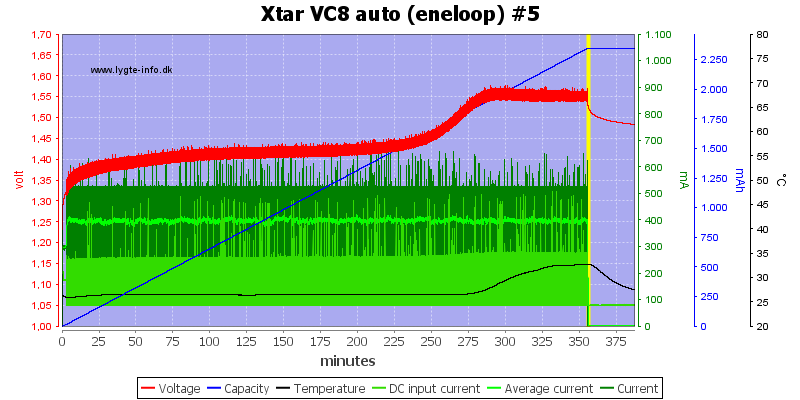
Display shows: 2220mAh, 111mOhm
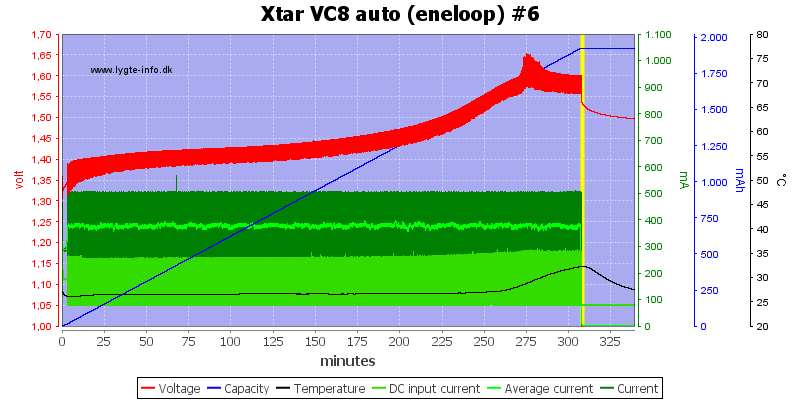
Display shows: 1916mAh, 275mOhm
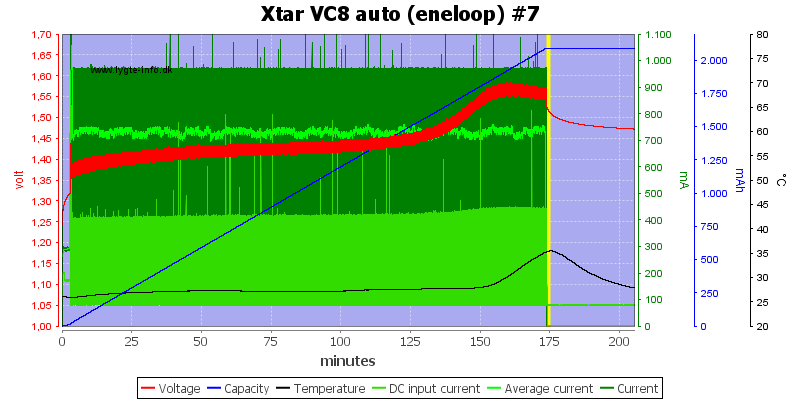
Display shows: 2108mAh, 0mOhm
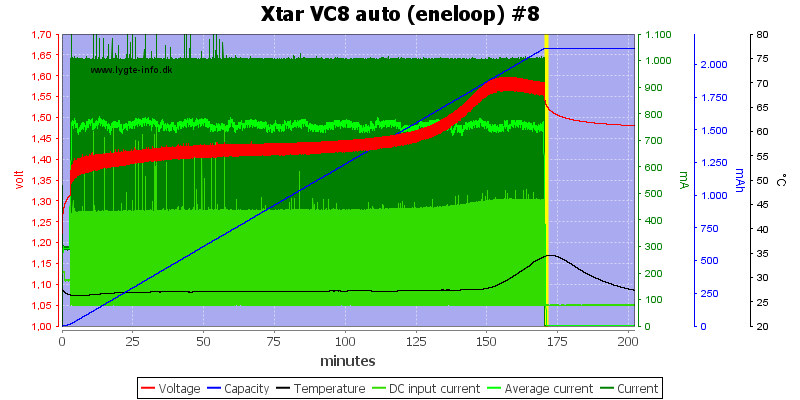
Display shows: 2109mAh, 76mOhm
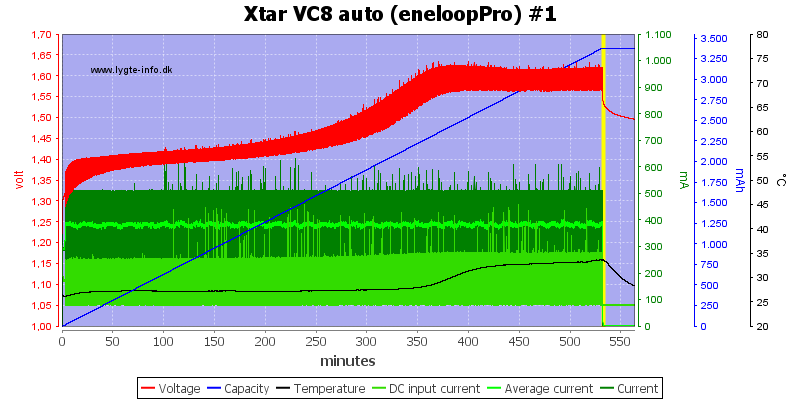
The enelope pro that is a bit old was slow to termination and was more than fully charged, but at 0.5A the temperature raise was limited.
Display shows: 3320mAh, 116mOhm
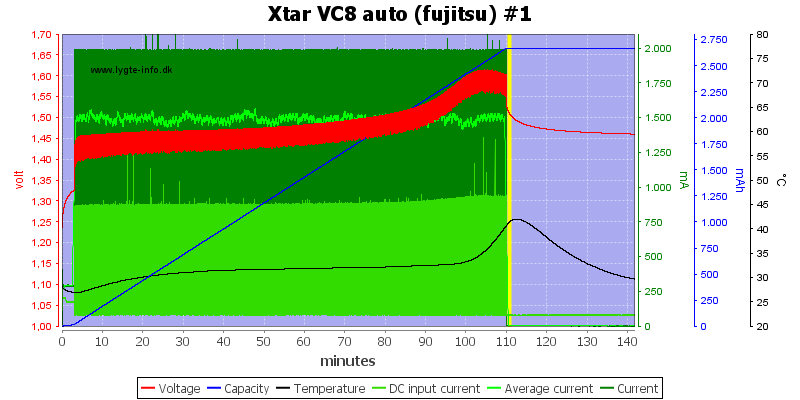
The Fujitsu charge was better and much faster.
Display shows: 2720mAh, 60mOhm
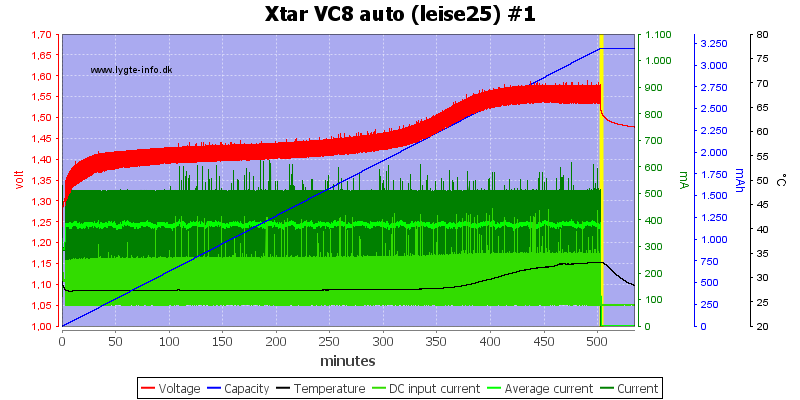
Display shows: 3139mAh, 154mOhm
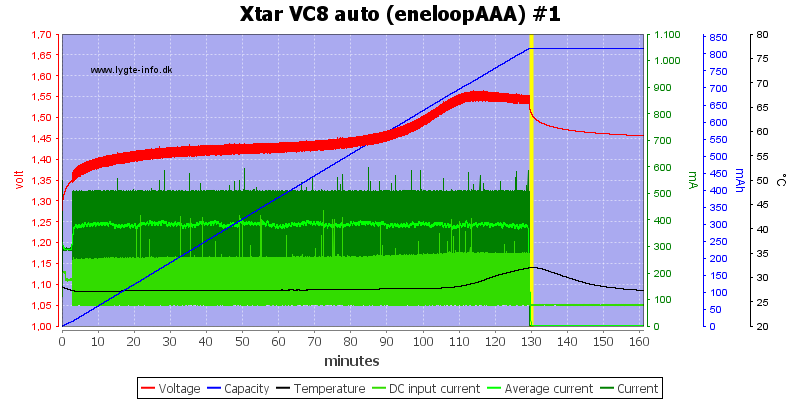
Display shows: 804mAh, 113mOhm
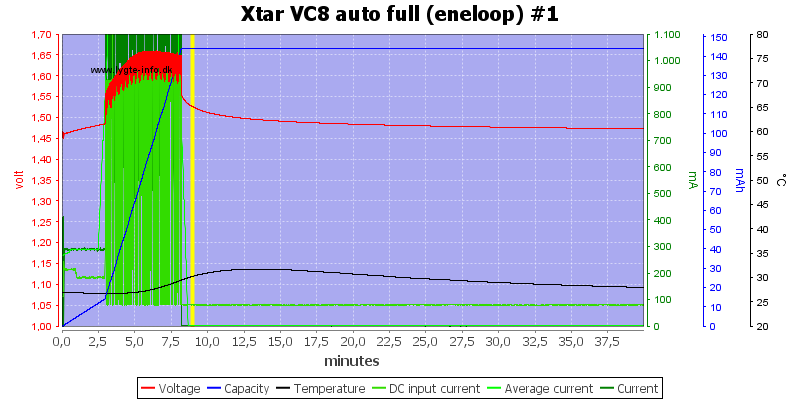
The full battery was stopped fairly quick for a -dv/dt charger.
Display shows: 147mAh, 60mOhm
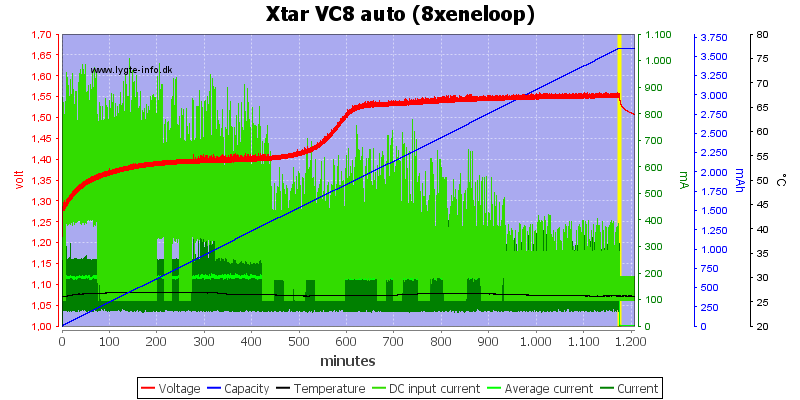
Display shows:
Capacity: 3606mAh, 2304mAh, 4201mAh, 1335mAh, 993mAh, 1347mAh, 603mAh, 2850mAh
Resistance: 63mOhm, 26mOhm, 28mOhm, 201mOhm, 39mOhm, 36mOhm, 32mOhm, 32mOhm
The first battery was serious overcharged and one some of the other there was some very low capacities: 1335mAh, 993mAh, 1347mAh, 603mAh was my batteries not empty or have they lost that much capacity? I put them on a SkyRC MC3000 charger and discharged them, that got me: 1287mAh, 1066mAh, 1379mAh, 626mAh. They must have been empty when I started, but have they lost capacity? I did a test on the MC3000 and all batteries was 1900mAh +/-15mAh, i.e. no significant capacity loss.
In another similar test I did the result was 2307, 3194, 3903 3273, 1044, 3301, 568, 3741
I.e. more overcharged batteries, but also some undercharged.
In these test I only have measuring equipment on slot #1, all the other are without any extra stuff between batteries and charger.
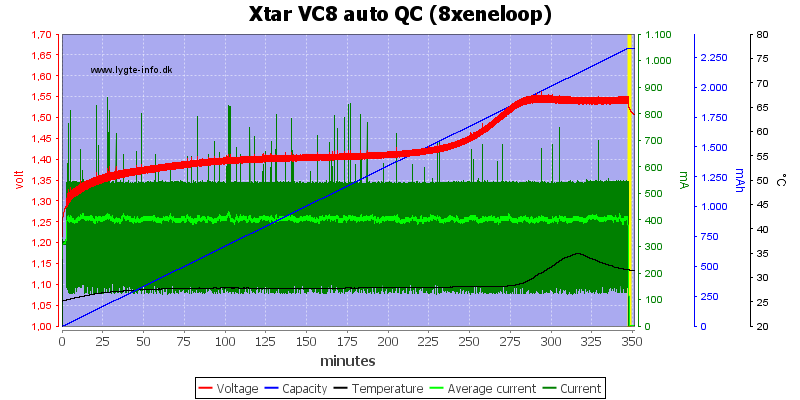
What about using a QC for power?
Display shows:
Capacity: 2173mAh , 2011mAh, 2435mAh, 2230mAh, 1956mAh, 2288mAh, 596mAh, 2179mAh
Resistance: 57mOhm, 27mOhm, 28mOhm, 26mOhm, 31mOhm, 30mOhm, 30mOhm, 27mOhm
The result is much better, but not perfect, one battery did fail with only 596mAh.
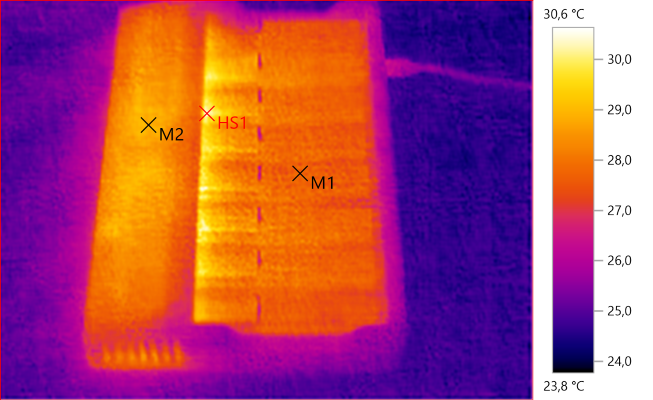
M1: 27.8°C, M2: 28.9°C, HS1: 30.6°C
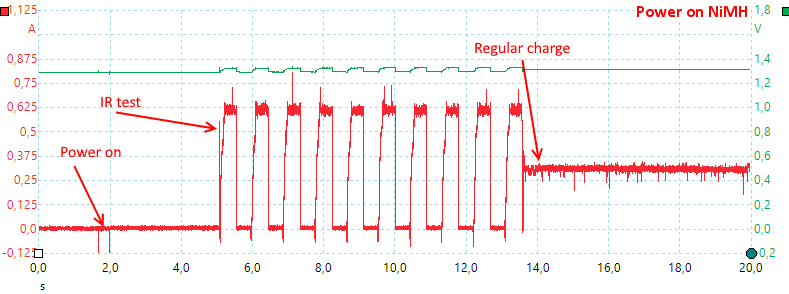
The charger uses the same time as for LiIon, before it starts on the charging. After a few minutes it may increase the current.

The charger handled unstable voltage considerable very nicely with NiMh.
Grading NiMh
A grading sequence consist of charge the battery, discharging it while measuring capacity and the charging it again (The last part do not really work here). Due to the low currents it is done at it takes a lot of time to do. This function is only available on the first four slots.
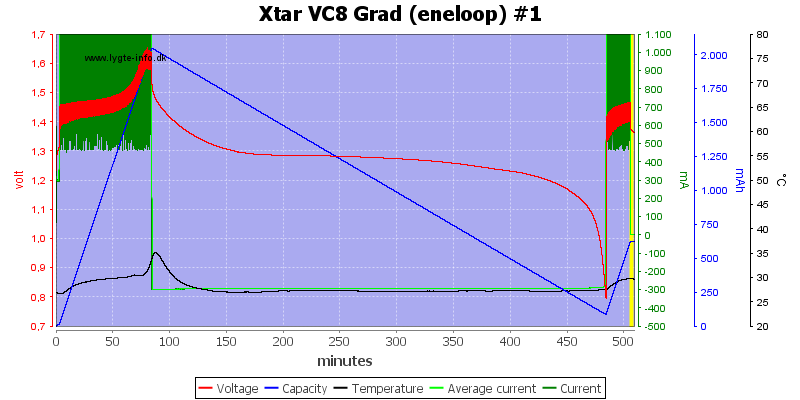
The batteries are discharged to about 0.8V
Display shows: 2022mAh
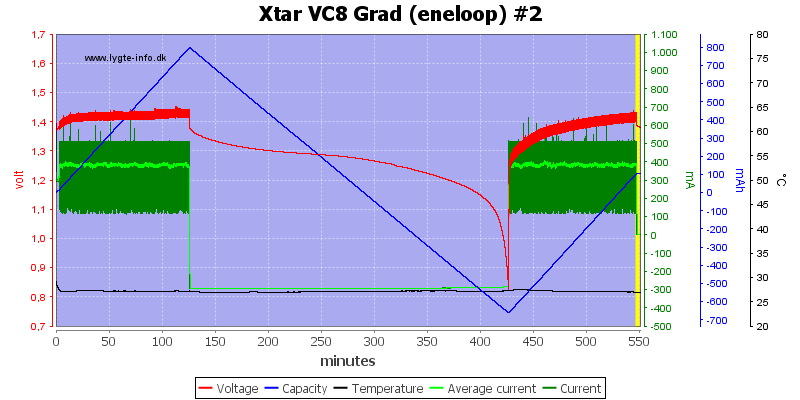
Oops, the first charging is bad and this means the capacity is wrong.
Display shows: 1521mAh
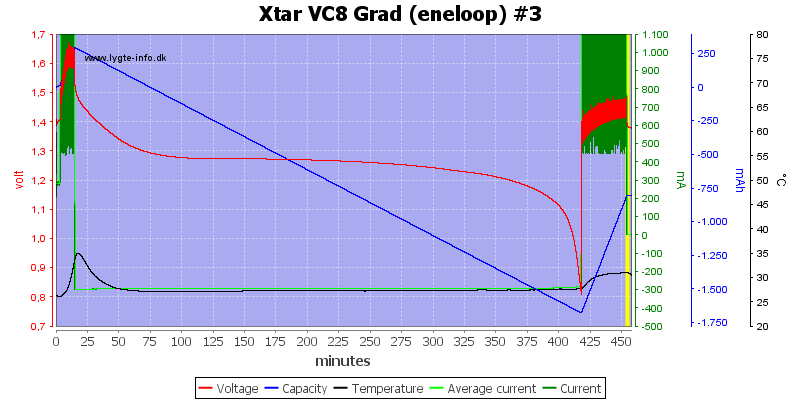
This test was done with a already charged battery and it got to the discharge part faster.
Display shows: 2038mAh
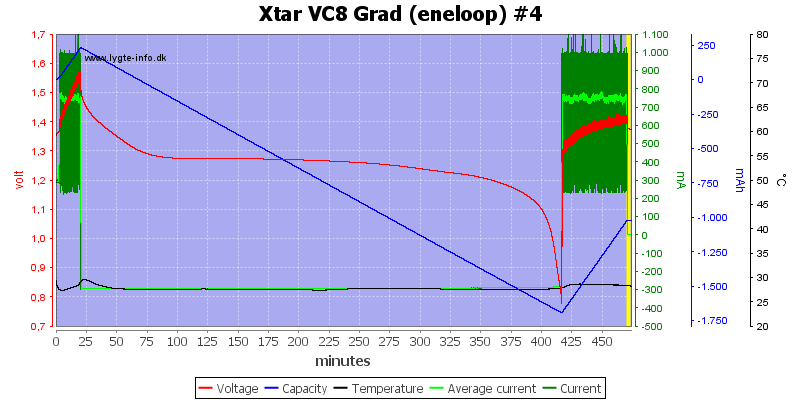
Again with a full battery, but I am missing the -dv/dt part of the first charge curve.
Display shows: 2004mAh
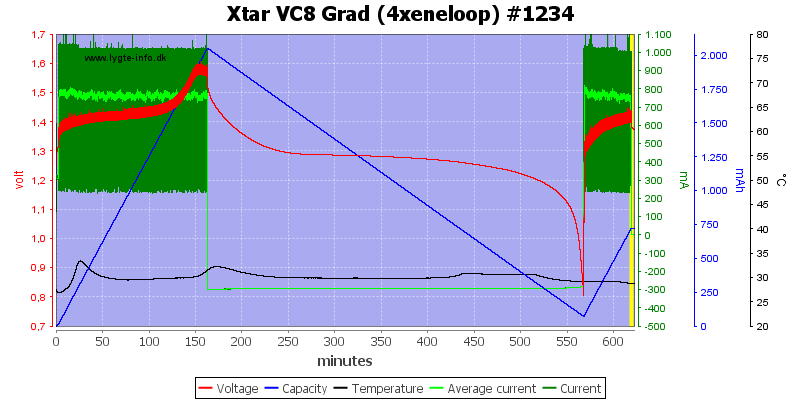
Grading four batteries at a time worked fine.
Display shows: 2045mAh, 2068mAh, 2063mAh, 2039mAh
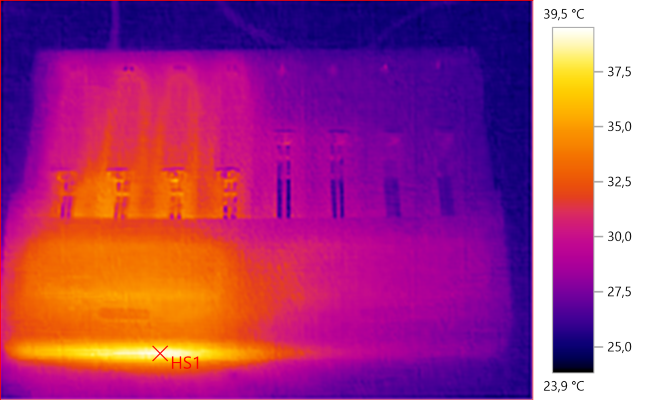
HS1: 39.5°C
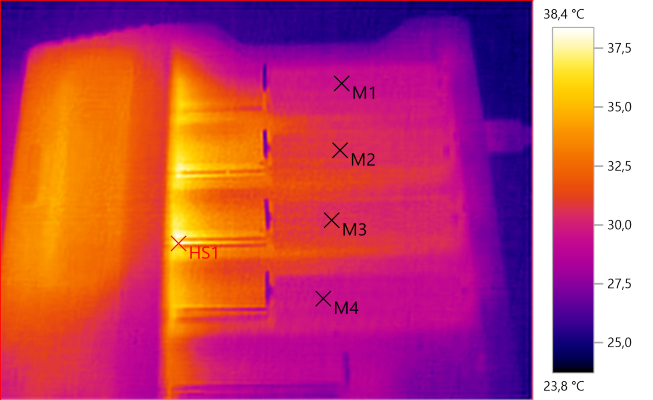
M1: 29.5°C, M2: 30.4°C, M3: 30.6°C, M4: 29.3°C, HS1: 38.4°C
Storing NiMH
Often NiMH is best stored fully charge, but this function will discharge them partially. I could not use it on discharged batteries. This function is only available on the first four slots.
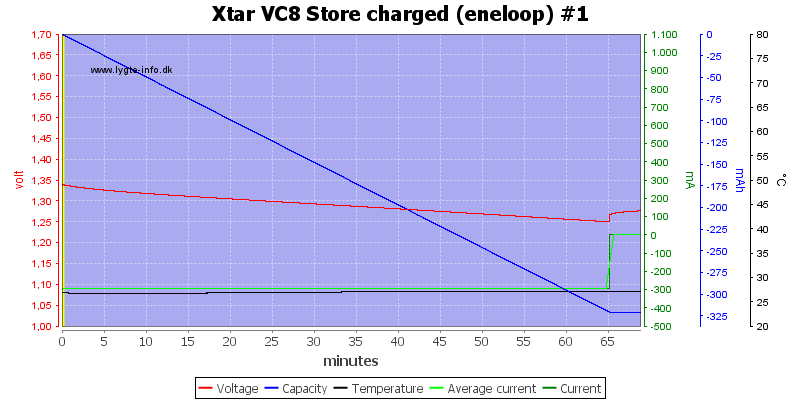
Display shows: 1.32V
Internal resistance
With 8 slots I did not want to use my detailed test, instead I checked the IR of a LiIon and a NiMH batteries with my own 4 terminal equipment, before and after measuring them on the charger.

When averaging all slots I got 15mOhm
My test got 25mOhm - 30mOhm, depending on if calculated when turning current on or off or before or after the test on the charger.

When averaging all slots I got 21mOhm
My test got 28mOhm - 32mOhm, depending on if calculated when turning current on or off or before or after the test on the charger.
There is some variation in the charger result, but it is in the correct range for the tested batteries.
Conclusion
With 8 channels this charger can get many LiIon charged fairly fast, without using a high current or a few cells fast using a high current (If the IR of the cells are low). The charger can also analyze batteries, but only on four slots.
In this charger the automatic current selection limits maximum selectable current, it is a good safety feature, but I am not really in favour of this automatic current selection, it is way to unpredictable (An it is even worse in my testing setup, due to extra contact resistance).
The charger did not do very well on NiMH. The recorded tracks are fairly fine, but the 8 cell tests are not. I do not like seeing my empty eneloop needing between 600mA and 4000mAh to be fully charged.
The storage function is fine for LiIon, but not for NiMH.
The LiIon part of the charger gets a good rating, but the NiMH rating is only acceptable.
Notes
The charger was supplied by a Xtar for review.
Here is an explanation on how I did the above charge curves: How do I test a charger






















































































